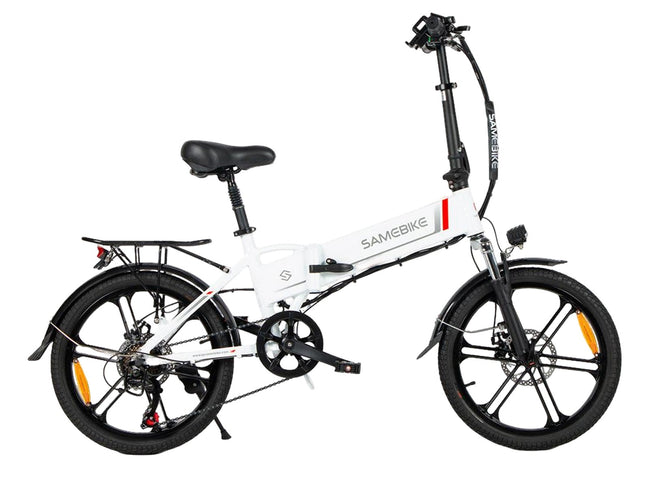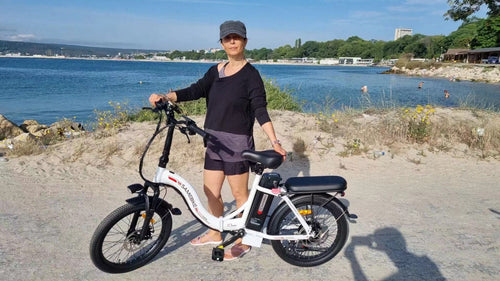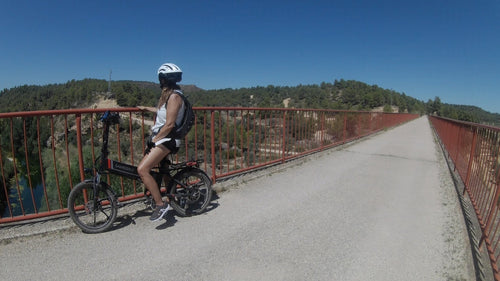There's never been a more exciting time to own your very own electric bike, especially with the advancements in technology, to improve performance, safety, and comfort. Thanks to its wide versatility. An Ebike can easily replace your city car even your motorcycle. The vast majority of models available aren't just lightweight and durable but even more affordable than before.
If you're a little hesitant about buying your own Ebike, let this article be your guide in helping you discover all of the unique capabilities and features of having your very own electric bike. And of course, just how much range can an average Ebike do - if you're still unsure, or you have questions, please contact us. We're to help.
Now, if you don't have any more questions, let's start with arguably the most important aspect of electric bikes, the Ebike range.

What's the Range for Electric Bikes?
Generally speaking, a fully charged long-range Ebike can give you a range of 20 miles to 100 miles or about 32 to 160 kilometers. The more expensive your Ebike, the more mileage you can travel with it as they usually have larger batteries some are even easy to replace. And to help you with power output, some models offer a power control system that balances various factors that help ensure that you reach your desired destination.
Pro Tip:
Consider purchasing an additional battery or two to greatly increase your range. Also, by you lowering the assistance level of your Ebike, it will not only preserve your battery but also helps in increasing your Ebike range.
How long does an Ebike take to charge?
Depends on what your Ebike's charger model is, what battery type it is, and how much capacity your battery has. In general, it takes 4-10 hours to fully recharge.
What Factors Influence the Ebike Range's Design?
In no particular sequence, these are the factors that can impact a long range Ebike:
- Battery Capacity - the bigger the battery, the further you can travel.
- Battery Charge Level - as a general rule when it comes to batteries, you never want to fully drain them and overcharge them. The idea is simple if you drain over and over again. Eventually, they'll lose their capacity to hold a charge for long or "drain" - all in all, take care of your battery and your battery will take care of you.
- Terrain - the higher the elevation you travel and/or descend from, the more battery power is being used. As well as how much you pedal and brake. The more smooth a surface is the less wear and tear, in your battery's capacity.
- Weather - whether you're riding against the wind, it's cold, or it's hot. All of these can affect your battery. This is why it is highly recommended that you keep your battery in a protective and insulated enclosure that maintains it at a constant temperature.
- Assist Level - by "assist" this means how much the electric motor is actually assisting (helping) you reduce the effort needed to pedal. The higher the assistance level, the more power it needs which leads to a drastic decrease in your Ebike range. Assist levels range from level 3 to 5 which feels like a gentle push to going down a steep sloop. Some Ebikes even include a "boost" that temporarily gives your Ebike brief acceleration.
- Riding Style - fast, slow, accelerate, decelerate, boost, stop, on, off, and so on. All of these "fun" activities can have a drastic effect on your battery's capacity. Also, generally speaking, you should avoid turning your Ebike on and off, as it can have a negative effect on your battery's quality of life.
- Tires - you want tires that best fit your weight and the terrain you're traveling. The less stress you put on the Ebike, the more long range Ebike you can have.
- Accessories - if you are to use front and/or brake lights. Please use a power bank, not your Ebike's battery, that's in a waterproof enclosure.
How Do You Estimate the Range of E-bikes?
Check the energy capacity of the battery pack of your eBike. The energy capacity of a battery pack is measured in Watt-hours.

Simply multiply the voltage (V) and the amp hours (Ah) of the battery pack to calculate the watt-hours (Wh) of a battery pack.
Formula: V x Ah = Wh
Examples:
A 50-volt 10-Ah battery has 500 Wh (watt hours).
With good energy usage, one mile of travel will cost 20-watt hours.
Therefore, a 500-watt-hour battery pack lets you travel 25 miles
50V 10Ah = 25 miles
A 40-volt 12-Ah battery has 480 Wh (watt hours)
With good energy usage, one mile of travel will cost 20-watt hours.
Therefore, a 480-watt-hour battery pack lets you travel 24 miles.
40V 12Ah = 24 miles
This is a rough estimate of how far you can travel on an eBike
- eBike range at a low level of pedal assist: XWh / 10 = range
- eBike range at a medium level of pedal assist: XWh / 20 = range
- eBike range at a high level of pedal assist: XWh / 30 = range
Note: An eBike with a low level of pedal assist will drain the battery slowest at a maximum range. While an eBike with a high level of pedal assist will drain the battery the quickest to get maximum power.
Examples:
- At a low pedal assist, a 500 Wh battery capacity/ 10 = You can travel 50 miles on a single charge
- At a medium pedal assist, a 500 Wh battery capacity/ 20 = You can travel 25 miles on a single charge.
- At a high pedal assist, a 500 Wh battery capacity/ 30 = You can travel 17 miles on a single charge.
Tips to Increase Your Ebike Range
1. Use other assistance modes
You also have to be in sports mode. You can use Eco mode for longer destinations.
2. The right gear
You don't necessarily have to be in a higher gear to get to your destination. A lower gear still works just as fine and it saves battery power.
3. Plan your route(s)
Unleash you're the spontaneous kind, planning your route will definitely help you determine how much range it will need to get you there.
4. Regenerative braking mode
There are some Ebike that have "regenerative braking" modes which basically means the kinetic energy produced during braking is transferred to your battery.
5. Stop & Go
Switching your Ebike's motor on and off can have a drastic effect on its battery levels. As much as, it is normal, to turn off your motor when you're quickly stopping by a convenience store. The sudden surge needed to turn on your motor is actually more power hunger than just leaving it on. Of course, if the area you're in isn't safe. Well, that's a whole other story.
6. Ebike range indicator
The range indicator not only tells you just how much batter you have left but often calculates if you can actually reach your desired destination.
7. Tire pressure
If your Ebike's tires are at their full potential, there's less drag on the motor, or less power is needed to carry you to your destination.
8. Always, always have an extra battery
This is personally been a lifesaver for me. There were so many times when a second or even third extra battery has come in handy.
9. Keep it Charged
Not only should you bring your charger with you everywhere and every day but always recharge your long range Ebike whenever it's not in use. Remember, never let it fully drain, overcharge, overheat, or cold even though most batteries can be charged over 1000+ times. It's best to take care of your battery.
10. Crouch
If you've ever seen competitive cross-country bikers, they're almost always tucked or crouched. They do this to reduce drag or air resistance.
11. Regular maintenance
Everything from brakes, your motor, tires, handles, etc. The less friction your Ebike has, the more it can perform especially if you reduce the weight it's carrying. However, if you're an adventurer and you bring lots of equipment. Just bring tools and extra batteries.
Conclusion
Honestly, if it's your first time learning or studying about electric bikes. It can be very intimidating but in reality, it's actually very simple. Think of a normal bicycle, strap a battery to it and that's about it. The best thing about long range Ebikes is that they're a much cheaper way of traveling than a car even a motorcycle.
Personally, one of the best things about electric bikes is their batteries. While not all offer the option to easily replace their batteries. Some do. Imagine, your average battery can travel for over 20 miles and you can easily double that when you have a spare battery. There are tons of riders including me that love this option. Downside? Often, these exchangeable battery Ebikes are of lower capacity ones meaning in terms of weight. Heavy
Proper maintenance (lubrication and oiling of chains, drivetrains, etc) will not only save you money, and headaches, and give your Ebike's battery that kind of quality of life that you can depend on for years and years to come. Owning your very own electric bike can quite literally change your life for the better.






































